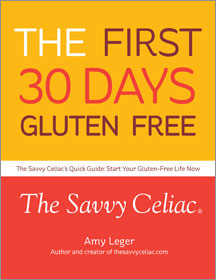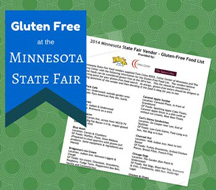There’s confusion among the general public about the difference between a food allergy and celiac disease. It is something we celiacs have known for a while. Usually when explaining what celiac disease is, most people believe if we get gluten there’s an anaphylactic reaction requiring emergency care. But that’s not the case.
Survey says…
The survey, conducted by Harris Interactive for HomeFree (an allergen-free cookie-maker), asked more than a thousand people to identify the top four food allergens. Only three percent got all four right: nuts, dairy, eggs and wheat. 43% incorrectly identified gluten as a top allergen.
Another question appeared to pose a scenario (note: I do not have the exact questions that were asked):
- If a person with a wheat allergy ate a brownie, would he have a life-threatening reaction requiring a shot of epinephrine?
- If a person who couldn’t eat gluten ate a brownie, would they have a similar life threatening response?
51% answered correctly on the wheat allergy question. 57% answered incorrectly with the question regarding gluten. Those respondents thought someone with celiac disease would have a an immediate life-threatening response when eating gluten. HomeFree offered a statement in its news release about the research, which EcoWorld picked up:
“People want to be able to serve food safely to other people…To do so, it helps to know that people with celiac disease…can get sick sometimes even from traces of gluten. If someone with food allergies eats even a trace of a food to which he or she is allergic, it can quickly lead to a life-threatening condition called anaphylaxis — which needs rapid treatment with epinephrine.” — Jill Robbins, president and founder of HomeFree.
The difference between celiac disease and a food allergy:
Technically celiac disease is an autoimmune disorder. A person who has celiac disease will have:
“…an immune reaction [which] occurs in your small intestine, causing damage to the surface of your small intestine and an inability to absorb certain nutrients” — source Mayoclinic.com.
The Mayo Clinic defines a food allergy as:
“…an immune system reaction that occurs soon after eating a certain food. Even a tiny amount of the allergy-causing food can trigger signs and symptoms such as digestive problems, hives or swollen airways. In some people, a food allergy can cause severe symptoms or even a life-threatening reaction known as anaphylaxis. An allergy is more of an instant reaction in which an epinephrine pen is needed– often anaphylactic endangering the life of the patient.”
In someone who hasn’t had to deal with either a food allergy or a gluten-reaction in celiac disease, I can understand why it’s easily confused. One easy way to understand is that an allergic reaction is usually quick — and can be severe. A gluten-reaction often takes a little longer to happen: hours or days. While for the lay-person it may make them believe that an accidental ingestion isn’t as serious as those with an allergy, in the immediate time that is probably correct in most cases. But over the long-haul, continuous accidental (or intentional) ingestion of gluten can be very dangerous to a person with celiac disease.
In fact sometimes I find by using the word “allergy” (only when necessary) — like at a restaurant, workers instantly take it more seriously. So while technically it’s not an allergy, it is a health issue that has a diet that must be adhered to– with no cross contamination.



Leave a Reply